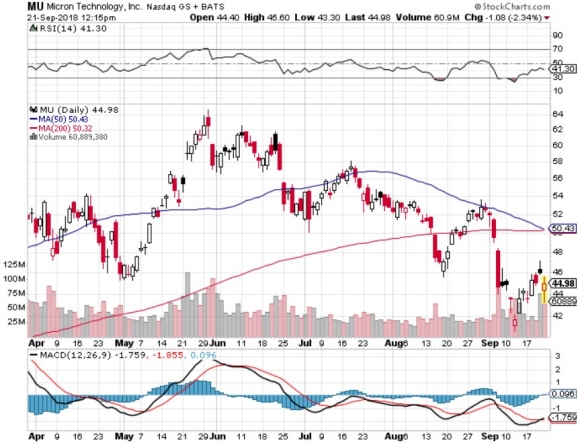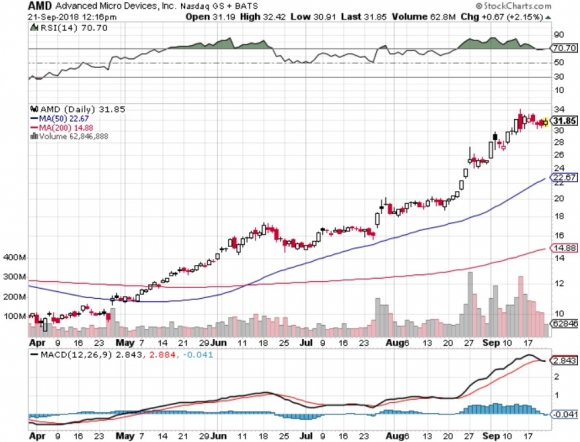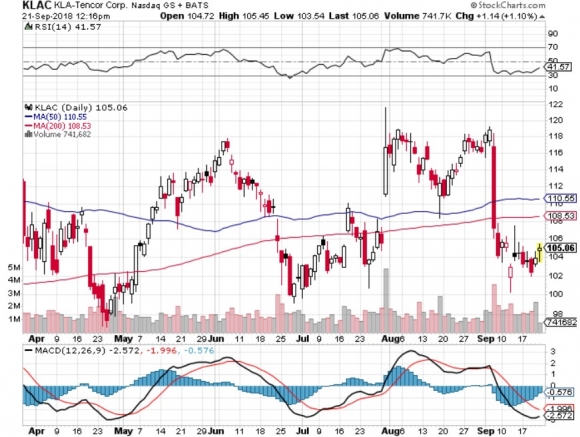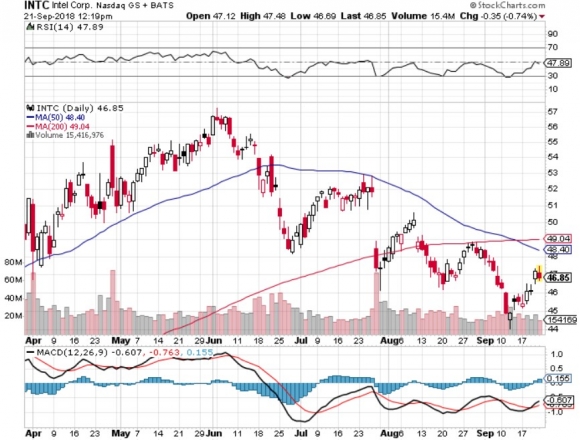If your stomach was on edge before, then you must feel quite queasy now.
That’s only if you didn’t get rid of your chip stocks when I told you to.
The chip sector has been rife with issues for quite some time now, and I’ve been firing off bearish chip stories the past few months.
Intel (INTC) was one of the last chip companies I told you to avoid like the plague, please click here to review that story.
The contagion has spread wider.
Micron (MU), the Boise, Idaho-based chip giant, delivered poor guidance from its latest earnings report, adding more carnage to this trouble sector.
It’s been rough sailing for many American-based chip companies lately that are not named Advanced Micro Devices (AMD) and Nvidia (NVDA).
The protracted ongoing trade war between America and China that sees no end in sight is the fundamental reason to stay away from these chip companies that are the meat and potatoes inside of all electronic devices.
Cofounder of Alibaba (BABA) Jack Ma, who recently stepped down from his position as chairman, told news outlets that this trade war could last “20 years” and is “going to be a mess.”
Micron is affected by this trade war more than any other American company, with half of its annual revenue derived from the Middle Kingdom.
Out of the $20.32 billion in annual revenue last year, more than $10 billion was from China alone.
Micron is a leader in selling DRAM chips, which are placed in most portable electronic devices such as smartphones, video game consoles, and laptop computers.
The commentary coming out from chip executives has been overly negative and spells doom and gloom - supporting my view to be cautious on chips through the end of the year.
At the Citi 2018 Global Technology Conference in New York, KLA-Tencor (KLAC) chief financial officer Bren Higgins characterized the winter season DRAM market as “little less than what we thought,” describing margins as “modestly weaker.”
Lam Research (LRCX), once one of my favorite chip plays, offered bearish rhetoric about the state of chip investments, saying on its earnings call that is expected “lower spending on new equipment by some of its memory customers.”
It doesn’t take a rocket scientist to know that “memory customer” is Intel, which is in the throes of a CPU chip shortage rocking the overall personal computer market.
Personal computers face a steep 7% drop in sales volume for the rest of the year, and the knock-on effect is rippling throughout the industry.
The lower volume of produced computers means less memory needed, adding up to less sales for Micron.
This rationale forced Micron to guide down its revenue growth from 22% to 16% for the last quarter of 2018.
Intel’s monumental lapse has offered a golden opportunity for competitor Advanced Micro Devices (AMD) to steal market share from Intel in broad daylight.
This was the exact thesis that provoked me to urge readers to pile into AMD shares like a Tokyo rush-hour subway car.
Shares have gone ballistic to say the least.
(AMD) is poised to seize and reposition itself in the global CPU market with a 70/30 market share, up from the paltry 90/10 market share before Intel’s debacle.
To make matters worse for Intel, widespread reports indicate its shortage problems are “worsening.”
Such is a dog-eat-dog world out there when a company can triple market share in a blink of an eye.
The rotation is real with HP (HPQ) planning to integrate AMD chips into 30% of its consumer PCs, and Dell already mentioning it will use AMD chips to make up for the shortages.
The resilience in chip demand remains the silver lining for this industry as price weakness and production shortages will be finite.
Server demand remains particularly robust.
Google, Amazon, Facebook, and Microsoft coughed up $34.7 billion on data centers to serve cloud-based operation in the first half of the year in 2018, a sharp increase of 59% YOY.
Investors have been paranoid of the boom-bust nature of the chip industry for decades.
Each cycle sees spending and chip pricing rocket, only for inventories to build up and demand to evaporate in an instant.
The beginning of the end always starts with lower guidance, followed up with missed earnings the next quarter.
This playbook has repeated itself over and over.
Micron guided first quarter revenue of 2019 in a range between $7.9 billion to $8.3 billion, lower than the consensus of $8.45 billion.
And, if all of this horrid chip news wasn’t reason to rip your hair out - here is the bombshell.
To wean itself off the reliance of American chips, Alibaba has created a subsidiary to produce its own chips called Pingtouge Semiconductor Company.
Pingtouge refers to honey badger in the Chinese language, symbolic for its tenacity in the face of adversity – perhaps a thinly-veiled dig at the American political system.
Former Chairman Ma pocketed this chip company Hangzhou C-SKY Microsystems last year. It will will be given ample leeway and resources to team up with Alibaba to roll out its first commercial chip next year.
Alibaba has rapidly grown into the third-largest cloud player in the world, and require an abundant source of chips moving forward.
Chips tricked out with artificial intelligence will be adopted by not only its data centers, but integrated with its autonomous driving technology and IoT products, which are markets that Alibaba is proud to be part.
You can find Alibaba’s cloud products present in more than 20 countries. And the company that Jack Ma built forecasts to generate more than 50% of its revenue from overseas markets soon.
It could be Jack Ma laughing all the way to the bank.
Ultimately, Micron produced fair results last quarter, but like Facebook found out, if investors believe the company is about to fall off a cliff, it offers little resistance to the share price on a short-term basis.
Could the cyclicality demons start to awake to drag this company down?
Partially, yes, but there are still many positives to take away from this leading chip company.
China will need years to remedy its addiction of American chips.
It will not be able to produce the scope of quality or quantity to just stop buying from American companies for the foreseeable future.
The authorized $10 billion share buyback gave Micron shares a nice lift earlier this year, but the industry dynamics are now deteriorating rapidly.
Chip sentiment is at its lowest ebb for some time, and I reaffirm my call to avoid this sector completely unless it’s the two cornerstone chip companies showing systematic resiliency - (AMD) or Nvidia (NVDA).
The administration initially slapped on a tariff rate of 10% on $200 billion worth of goods with intentions to scale it up.
If nothing is solved, the increase to 25% will cause another 5% to 10% drop in Micron and Intel.
Then if the administration plans to go after the rest of the $250 billion of Chinese imports, expect another dive in chip shares.
Either way, each jawboning tweet as we head deeper into this trade conflict will damage Micron’s shares.
This sector is getting squeezed from many sides now, and if you don’t go outright short chip companies, then stay away until the storm clouds pass over and you can reassess the situation.







